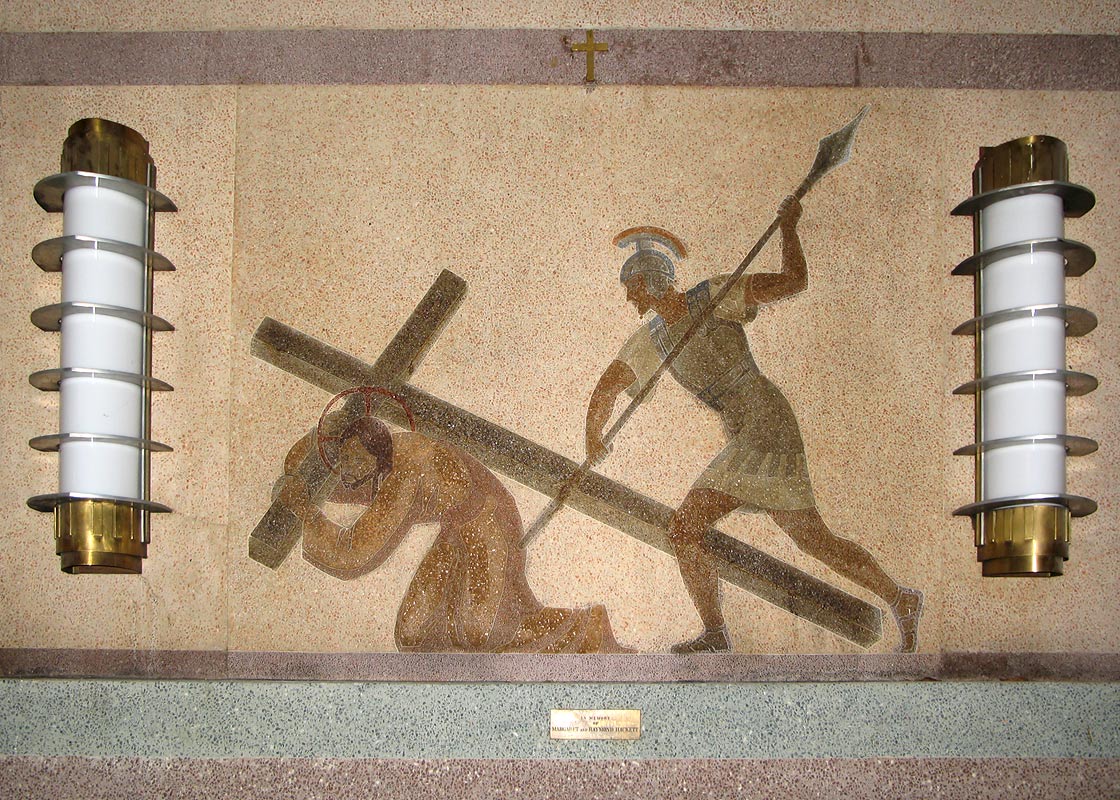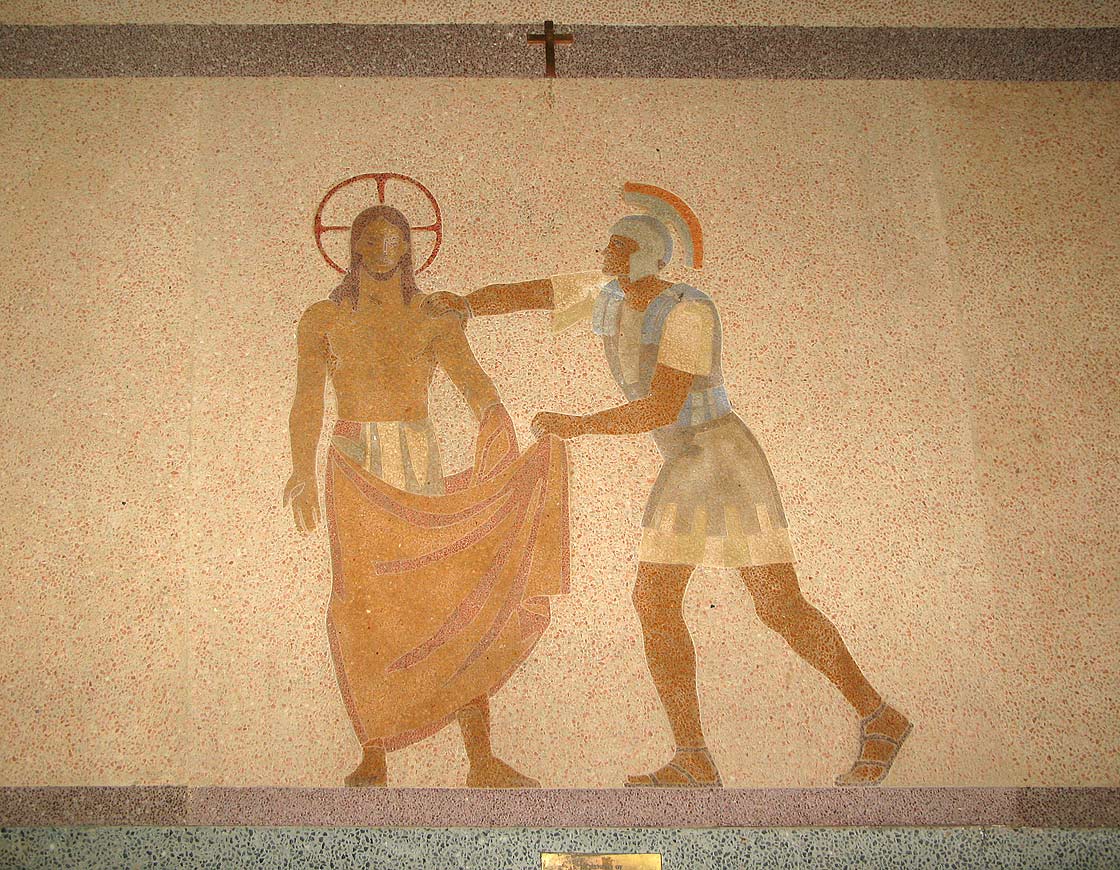Hildreth Meière Documentary Series - Watch Trailer
Hildreth Meière Documentary Series - Watch Trailer
Commissioned by: Joseph Sanford ShanleyMedium: terrazzoExecuted by: John J. Earley

Exterior of octagonally-shaped St. Charles Borromeo Church

Detail of entrance to St. Charles Borromeo Church
Shortly after having completed work on St. Michael’s Passionist Monastery Church in Union City, New Jersey, Meière received a commission from the Newark-based architect Joseph Sanford Shanley to design Stations of the Cross for the octagonally-shaped St. Charles Borromeo Church in downtown Newark. At the time, Shanley was treasurer of the Liturgical Arts Society, which Meière had helped found.
Shanley conceived a church which would be relatively small, functional, and suited to the square plot of land upon which it was to be built. Hence he designed it octagonal in shape instead of cross-shaped, without pillars to permit full view from every part.
The circular-church effect, which is produced inside by four similar arches at the north, east, south, and west sides of the church, tends to produce a congregation-centered effect, a spirit which is in full harmony with later liturgical changes. Further, the similarity of the altar alcove with the other three alcoves tends to unite the altar to the congregation, rather than separate them, as is so common in a cruciform church.1
Shanley introduced Meière to the Virginia-based architectural sculptor John J. Earley, who executed Meière’s designs in terrazzo, a medium composed of cement, marble or glass chips, sand, and color. She believed that Shanley was “doing a most interesting thing and a very important one by way of pioneering” in his willingness to experiment with what was for her a new medium. Meière designed the Stations of the Cross in terrazzo in her characteristically modern style, with Art Deco touches throughout.
The Stations of the Cross decorate the walls of the arched alcoves on the north, west, and south sides of the church. The narrative panels begin in the north alcove with the following scenes: Pilate washes his hands; Jesus accepts his cross; and Jesus falls for the first time:

North alcove, right to left: Pilates washes his hands; Jesus accepts his cross; (far left) Jesus falls for the first time

Pilate washes his hands

Jesus accepts his cross

Jesus falls for the first time
The narrative continues from right to left in the west alcove, where one enters the church, with Jesus meets his mother and Simon helps carry the cross. To the right of the entrance doors Meière depicted Veronica wipes the face of Jesus and Jesus falls for the second time; to the left of the entrance doors she represented Jesus meets women of Jerusalem and Jesus falls for the third time. Jesus is stripped of his clothes and Jesus is nailed to the cross complete the alcove:

Entrance to church in west alcove, right to left: (barely visible on north wall to right): Jesus meets his mother and Simon helps carry the cross; Veronica wipes the face of Jesus; Jesus falls for the second time; Jesus meets women of Jerusalem; Jesus falls for the third time; (barely visible on south wall to left) Jesus is stripped of his clothes; Jesus is nailed to the cross

Jesus meets his mother

Simon helps Jesus carry the cross

Veronica wipes the face of Jesus

Jesus falls for the second time

Jesus meets the women of Jerusalem

Jesus falls for the third time

Jesus is stripped of his clothes

Jesus is nailed to the cross
The final scenes in Meière’s Stations of the Cross decorate the south alcove. These include Jesus dies on the cross; Jesus is taken down from the cross; and Jesus is placed in the tomb:

South alcove, right to left: Jesus dies on the cross; Jesus is taken down from the cross; Jesus is placed in the tomb

Jesus dies on the cross

Jesus is taken down from the cross

Jesus is placed in the tomb
The background color of the figurative terrazzo panels matches the color of the terrazzo walls into which they were inserted. A decorative pattern of dark grey horizontal lines running throughout the sanctuary at the same height as the base and top of the panels helps blend the Stations of the Cross into the walls. Upon close examination, however, one can discern the seams to the left and right of the figure groups where the narrative panels were set into the walls.
Earley called the technique he used to execute Meière’s designs “cast mosaic.” Working in his Virginia studio, he cast sample panels of Meière’s figurative scenes in terrazzo. Once the panels had hardened sufficiently, he shipped them to Meière for her approval, writing:
We have just taken the cast of your sample out of the mould. It came out very well. I hope you will be pleased.2
Meière trusted Earley’s eye and his ability to improve upon her designs as he executed them. In reference to one of her cartoons she wrote:
I hope you will feel free to do with the drawing and color whatever in your judgment will produce the best result.3
Meière was comfortable allowing Earley to interpret her designs for the Stations of the Cross in terrazzo, just as she trusted skilled craftsmen to execute her work in various other mediums. Meière’s Stations of the Cross are in place today, although St. Charles Borromeo has become the Greater Friendship Baptist Church. This commission was Meière’s only use of terrazzo to decorate a church.
Robert Wister, “Churches of the Archdiocese of Newark,” http://blogs.shu.edu/newarkchurches/archives/613
John J. Earley, letter to Hildreth Meière, March 19, 1937. Hildreth Meière Papers, Archives of American Art, Smithsonian Institution, Washington, DC.
Meière, letter to Earley, March 25, 1937, HM Papers.

Greater Friendship Baptist Church
84 Custer Avenue
Newark, NJ 07112